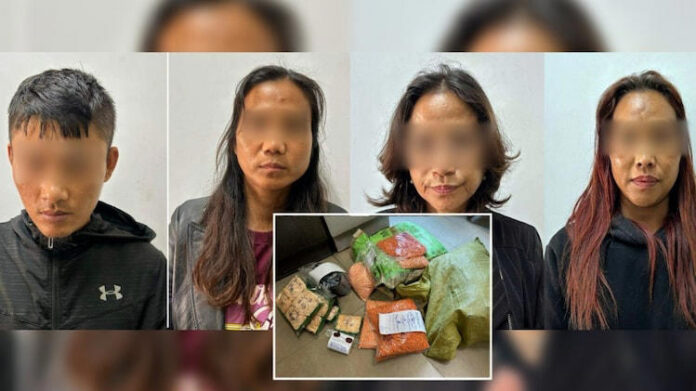The authorities in Mizoram recently made a significant seizure, apprehending three women, including two Myanmar nationals, with over 5 kilograms of methamphetamine. The incident underscores the persistent challenges faced by law enforcement agencies in combating the illicit drug trade and the crucial role played by collaborative efforts in curbing such criminal activities.
Mizoram, nestled in the northeastern corner of India, is renowned for its lush greenery, rich cultural heritage, and warm hospitality. However, like many regions across the globe, it is not immune to the scourge of drug trafficking, which threatens the safety and well-being of its residents. The recent apprehension of three women with a substantial quantity of methamphetamine serves as a stark reminder of the pervasive nature of the drug trade and the constant vigilance required to combat it effectively.
The operation leading to the apprehension of the trio was the result of diligent efforts and coordination among various law enforcement agencies. Acting on intelligence inputs, authorities conducted a targeted operation, intercepting a vehicle suspected to be carrying illegal narcotics. Upon searching the vehicle, they made the alarming discovery of over 5 kilograms of methamphetamine concealed within.
The apprehended individuals, including two Myanmar nationals and one Indian woman, were promptly taken into custody for further investigation. The seizure of such a significant quantity of methamphetamine underscores the magnitude of the illicit drug trade and the organized networks involved in its distribution. It also highlights the importance of robust enforcement measures and international cooperation in tackling transnational crime.
Methamphetamine, commonly known as meth, crystal, or ice, is a highly addictive stimulant drug that poses serious health risks to users and fuels a cycle of addiction and crime. Its production and trafficking have far-reaching consequences, including social, economic, and public health implications. The seizure of over 5 kilograms of methamphetamine in Mizoram represents a major blow to the illicit drug trade and sends a strong message to those involved in such criminal activities.
While the apprehension of the trio is undoubtedly a significant achievement for law enforcement agencies, it also underscores the need for sustained efforts to address the root causes of drug trafficking. Poverty, unemployment, and lack of educational opportunities are often cited as underlying factors driving individuals into the drug trade. Addressing these socio-economic challenges requires a multi-faceted approach that encompasses not only law enforcement but also community engagement, rehabilitation programs, and support for vulnerable populations.
Mizoram, like other states in the Northeast region, shares porous borders with neighboring countries, making it vulnerable to cross-border smuggling activities. The presence of insurgent groups and ethnic tensions further complicates the security landscape, providing fertile ground for illicit activities such as drug trafficking. Addressing these complex challenges requires a comprehensive strategy that involves close coordination between state and central agencies, as well as cooperation with international partners.
In recent years, Mizoram has witnessed an increase in drug-related incidents, raising concerns among authorities and residents alike. The proliferation of synthetic drugs such as methamphetamine poses a grave threat to public health and safety, necessitating concerted efforts to stem the tide of drug trafficking. The apprehension of three women with over 5 kilograms of methamphetamine is a testament to the determination of law enforcement agencies to tackle this menace head-on.
As the investigation into the recent seizure continues, authorities remain vigilant in their efforts to disrupt and dismantle drug trafficking networks operating in Mizoram and beyond. The collaboration between various agencies, including police, customs, and intelligence, is crucial in identifying and apprehending those involved in illicit drug activities. By working together, we can create a safer and healthier environment for all residents, free from the scourge of drugs and organized crime.




